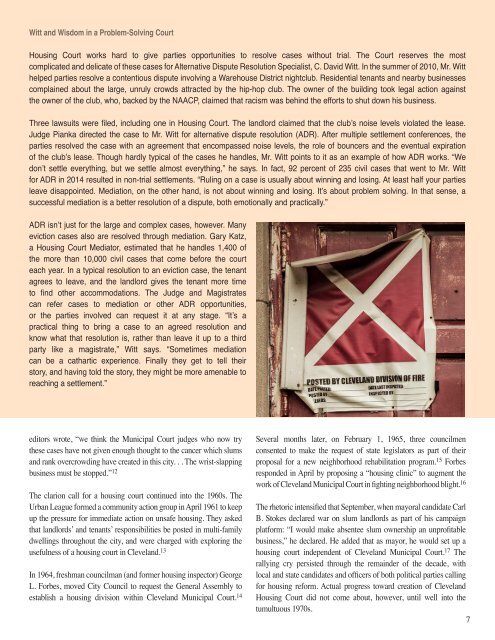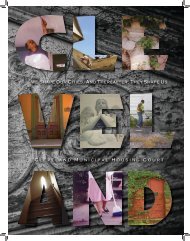Cleveland Housing Court
A detailed look at the 35th Anniversary of the Cleveland Municipal Court's Housing Division.
A detailed look at the 35th Anniversary of the Cleveland Municipal Court's Housing Division.
You also want an ePaper? Increase the reach of your titles
YUMPU automatically turns print PDFs into web optimized ePapers that Google loves.
Witt and Wisdom in a Problem-Solving <strong>Court</strong><br />
<strong>Housing</strong> <strong>Court</strong> works hard to give parties opportunities to resolve cases without trial. The <strong>Court</strong> reserves the most<br />
complicated and delicate of these cases for Alternative Dispute Resolution Specialist, C. David Witt. In the summer of 2010, Mr. Witt<br />
helped parties resolve a contentious dispute involving a Warehouse District nightclub. Residential tenants and nearby businesses<br />
complained about the large, unruly crowds attracted by the hip-hop club. The owner of the building took legal action against<br />
the owner of the club, who, backed by the NAACP, claimed that racism was behind the efforts to shut down his business.<br />
Three lawsuits were filed, including one in <strong>Housing</strong> <strong>Court</strong>. The landlord claimed that the club’s noise levels violated the lease.<br />
Judge Pianka directed the case to Mr. Witt for alternative dispute resolution (ADR). After multiple settlement conferences, the<br />
parties resolved the case with an agreement that encompassed noise levels, the role of bouncers and the eventual expiration<br />
of the club’s lease. Though hardly typical of the cases he handles, Mr. Witt points to it as an example of how ADR works. “We<br />
don’t settle everything, but we settle almost everything,” he says. In fact, 92 percent of 235 civil cases that went to Mr. Witt<br />
for ADR in 2014 resulted in non-trial settlements. “Ruling on a case is usually about winning and losing. At least half your parties<br />
leave disappointed. Mediation, on the other hand, is not about winning and losing. It’s about problem solving. In that sense, a<br />
successful mediation is a better resolution of a dispute, both emotionally and practically.”<br />
ADR isn’t just for the large and complex cases, however. Many<br />
eviction cases also are resolved through mediation. Gary Katz,<br />
a <strong>Housing</strong> <strong>Court</strong> Mediator, estimated that he handles 1,400 of<br />
the more than 10,000 civil cases that come before the court<br />
each year. In a typical resolution to an eviction case, the tenant<br />
agrees to leave, and the landlord gives the tenant more time<br />
to find other accommodations. The Judge and Magistrates<br />
can refer cases to mediation or other ADR opportunities,<br />
or the parties involved can request it at any stage. “It’s a<br />
practical thing to bring a case to an agreed resolution and<br />
know what that resolution is, rather than leave it up to a third<br />
party like a magistrate,” Witt says. “Sometimes mediation<br />
can be a cathartic experience. Finally they get to tell their<br />
story, and having told the story, they might be more amenable to<br />
reaching a settlement.”<br />
editors wrote, “we think the Municipal <strong>Court</strong> judges who now try<br />
these cases have not given enough thought to the cancer which slums<br />
and rank overcrowding have created in this city. . . The wrist-slapping<br />
business must be stopped.” 12<br />
The clarion call for a housing court continued into the 1960s. The<br />
Urban League formed a community action group in April 1961 to keep<br />
up the pressure for immediate action on unsafe housing. They asked<br />
that landlords’ and tenants’ responsibilities be posted in multi-family<br />
dwellings throughout the city, and were charged with exploring the<br />
usefulness of a housing court in <strong>Cleveland</strong>. 13<br />
In 1964, freshman councilman (and former housing inspector) George<br />
L. Forbes, moved City Council to request the General Assembly to<br />
establish a housing division within <strong>Cleveland</strong> Municipal <strong>Court</strong>. 14<br />
Several months later, on February 1, 1965, three councilmen<br />
consented to make the request of state legislators as part of their<br />
proposal for a new neighborhood rehabilitation program. 15 Forbes<br />
responded in April by proposing a “housing clinic” to augment the<br />
work of <strong>Cleveland</strong> Municipal <strong>Court</strong> in fighting neighborhood blight. 16<br />
The rhetoric intensified that September, when mayoral candidate Carl<br />
B. Stokes declared war on slum landlords as part of his campaign<br />
platform: “I would make absentee slum ownership an unprofitable<br />
business,” he declared. He added that as mayor, he would set up a<br />
housing court independent of <strong>Cleveland</strong> Municipal <strong>Court</strong>. 17 The<br />
rallying cry persisted through the remainder of the decade, with<br />
local and state candidates and officers of both political parties calling<br />
for housing reform. Actual progress toward creation of <strong>Cleveland</strong><br />
<strong>Housing</strong> <strong>Court</strong> did not come about, however, until well into the<br />
tumultuous 1970s.<br />
7



